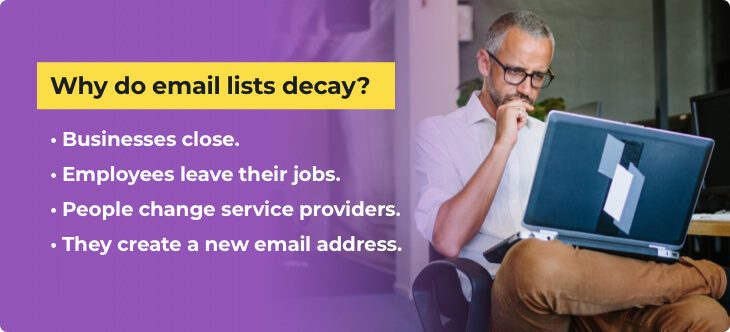
ZeroBounce Report: 5 Email Database Decay Insights to Apply to Your Email Marketing
Every year, around 23% of your email list churns. That’s just one of the findings we share with you in our newly-released report on email database decay. Get never-published-before data and insights to help you improve email marketing results in 2023.
As a marketer or business owner, you work hard to build your email list. So learning that almost a quarter of it deteriorates yearly is discouraging.
Nonetheless, email database decay affects everybody – small and large businesses alike.
To get an in-depth look at the average rate an email list degrades, we analyzed billions of emails ZeroBounce verified in 2022. Then, we gathered that data in an exclusive report.

The Email List Decay Report for 2023 is now live and brings you a unique look into the lifecycle of email data. So you know how to…
- handle your email list
- grow it the right way
- and get the highest ROI from the emails you send.
Below, we’ll look at five of the most significant findings – and the role they play in your email marketing strategy.
But first…
What is email database decay?
Email database decay refers to the rate at which an email list degrades. Addresses that were once valid churn due to people leaving jobs or switching to new addresses.
Email lists can also acquire other types of undesirable contacts, such as spam traps, known complainers or disposable emails. Obsolete data affects email deliverability and email marketing ROI.
A close look at email database decay: five findings from the ZeroBounce report
In 2022, ZeroBounce processed more than six billion email addresses. Our software checked their validity – but that’s not all. The email verifier detects more than 30 types of risky email addresses. While some of them are seemingly valid, they will affect your sender score and prevent you from reaching the inbox.
Here are five of the most eye-opening facts from the ZeroBounce Email List Decay Report for 2023.

#1. Almost 23% of an email list degrades yearly
Email decay is natural, and it happens across databases of all sizes. What may be surprising to some of you, though, is how fast data deteriorates. Our analysis showed that at least 22.71% of an email list goes bad yearly.
Why it matters: Poor-quality data has a tremendous impact on your email marketing results. When your bounce rate exceeds 2%, your sender score – or sender reputation – goes down. As a result, your inbox reach will decrease.
What to do: Run your email list through an email checker regularly. It’s the fastest and most reliable way to determine how much of your data went bad – and remove it right away.
#2. Invalid email addresses make up most of the poor-quality data
In 2022, 20.19% of all the poor-quality contacts ZeroBounce checked were invalid email addresses. While not surprising, this number shows just how fragile email data is. Some of these invalid emails were invalid to begin with, others became obsolete over time.
Why it matters: Bounces are detrimental to your sender score and sabotage your email deliverability. A high bounce rate (higher than 2%) can be reason enough for your emails to begin going to spam.
RELATED: Why emails go to spam – and what to do about it
What to do: First, check your entire email list to identify which contacts have churned and need to go. Then, consider connecting a real-time email verification service to your registration and sign-up forms.
The ZeroBounce API checks every email address in real time and prevents invalid emails from getting on your list. It’s an effective method to control email database decay.

#3. Typos are prevalent, causing bounces and lost leads
In 2022 alone, the ZeroBounce email verification API detected more than 10 million typos people made while trying to input their email addresses. The real-time email verifier automatically prompted users to correct the misspellings, thus ensuring they entered a valid contact.
Why it matters: Misspelled email addresses are not just useless – they’ll bounce and hurt your sender reputation. If you don’t use double opt-in or a real-time email verifier, there’s nothing stopping them from being added to your email list. Not only will you get bounces, but your new prospects will never hear from you, which will leave a poor impression of your brand.
What to do: Set up double opt-in to ensure you keep fake sign-ups at bay and that people enter a valid email address. Additionally, connect an email validation API to your forms – it checks every contact instantly, prevents typos and helps you avoid email list decay.
#4. Disposable emails are popular – and bad for your email marketing
ZeroBounce detected more than five million disposable emails in 2022. These email addresses tend to have a short shelf life and bounce, which is why the email industry also calls them burner or throw-away email addresses.
Why it matters: The marketing value of disposable emails is almost non-existent. Aside from skewing your engagement rates, burner emails self-destruct and cause your bounce rate to increase. Your goal is to keep your bounce rate as low as possible, so any type of contact that contributes to it is only hurting your email marketing.
What to do: Have a real-time email verifier connected to your sign-up forms. It will flag disposable emails and prevent them from spoiling your database. Additionally, make sure to remove throw-away emails when you clean your email list in bulk.
RELATED: Email list management – Infographic

#5. Things are getting better, but poor-quality data is pervasive
In 2022, only 57.21% of the email addresses that ZeroBounce verified were valid. It’s the most astounding fact we uncovered by looking at all the data our software processed. But things are looking up: in 2022, the overall data quality was 0.45% better than in 2021.
Why it matters: As a business owner or email marketer, you spend resources to acquire, nurture and convert leads. If only a little over 57% of these email leads are genuine, how good of a deal are you getting?
What to do: Have several filters in place to make sure that the email contacts you gather are valid and active. Set up double opt-in, verify your email list regularly and consider running every new email through a real-time email validator.
Bonus tip: If your email listis growing slowly, try using our free email verifier. It takes only seconds to see whether a lead you get is real or not. Also, you could sign up for a free ZeroBounce account and check 100 email addresses at no cost – every month.
You can’t avoid email database decay – but you can remove obsolete emails consistently and prevent them from getting on your list.
To land in the inbox and see your email marketing produce results, be mindful of the data you use and send emails that make a difference. It’s how you build a healthy, engaged, ROI-boosting email list.
Get an in-depth look at the ZeroBounce Email List Decay Report for 2023
FAQs about email database decay
Data decay refers to the degradation of data such as email addresses. Email database decay causes businesses to lose leads and revenue opportunities. You can stay on top of data decay by verifying and removing obsolete data regularly.
On average, 22.71% of an email list decays in a single year. Email addresses churn as people switch jobs or email providers. Email data decay causes bounces, sender reputation and email deliverability issues.
Email database decay affects email marketing by causing damage to your sender reputation. A poor sender reputation or sender score can cause your email marketing campaigns to land in the spam folder. The best way to prevent email database decay is by being mindful of the email addresses you gather and verifying your email list regularly.
Table of Contents
- What is email database decay?
- A close look at email database decay: five findings from the ZeroBounce report
- #1. Almost 23% of an email list degrades yearly
- #2. Invalid email addresses make up most of the poor-quality data
- #3. Typos are prevalent, causing bounces and lost leads
- #4. Disposable emails are popular – and bad for your email marketing
- #5. Things are getting better, but poor-quality data is pervasive
- FAQs about email database decay






